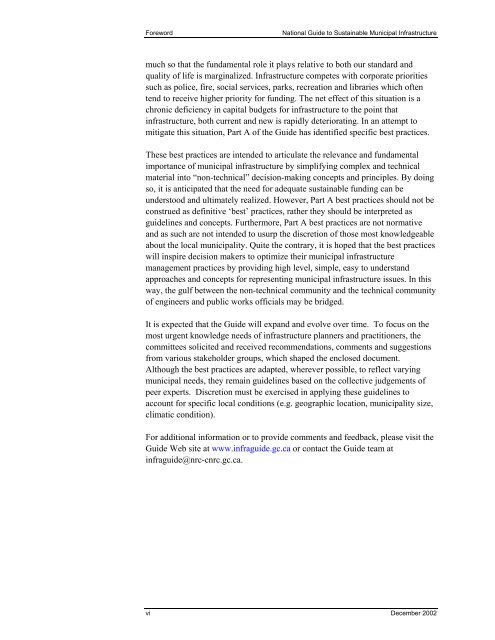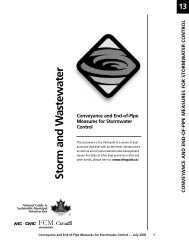ALTERNATIVE FUNDING MECHANISMS - FCM
ALTERNATIVE FUNDING MECHANISMS - FCM
ALTERNATIVE FUNDING MECHANISMS - FCM
Create successful ePaper yourself
Turn your PDF publications into a flip-book with our unique Google optimized e-Paper software.
Foreword National Guide to Sustainable Municipal Infrastructure<br />
much so that the fundamental role it plays relative to both our standard and<br />
quality of life is marginalized. Infrastructure competes with corporate priorities<br />
such as police, fire, social services, parks, recreation and libraries which often<br />
tend to receive higher priority for funding. The net effect of this situation is a<br />
chronic deficiency in capital budgets for infrastructure to the point that<br />
infrastructure, both current and new is rapidly deteriorating. In an attempt to<br />
mitigate this situation, Part A of the Guide has identified specific best practices.<br />
These best practices are intended to articulate the relevance and fundamental<br />
importance of municipal infrastructure by simplifying complex and technical<br />
material into “non-technical” decision-making concepts and principles. By doing<br />
so, it is anticipated that the need for adequate sustainable funding can be<br />
understood and ultimately realized. However, Part A best practices should not be<br />
construed as definitive ‘best’ practices, rather they should be interpreted as<br />
guidelines and concepts. Furthermore, Part A best practices are not normative<br />
and as such are not intended to usurp the discretion of those most knowledgeable<br />
about the local municipality. Quite the contrary, it is hoped that the best practices<br />
will inspire decision makers to optimize their municipal infrastructure<br />
management practices by providing high level, simple, easy to understand<br />
approaches and concepts for representing municipal infrastructure issues. In this<br />
way, the gulf between the non-technical community and the technical community<br />
of engineers and public works officials may be bridged.<br />
It is expected that the Guide will expand and evolve over time. To focus on the<br />
most urgent knowledge needs of infrastructure planners and practitioners, the<br />
committees solicited and received recommendations, comments and suggestions<br />
from various stakeholder groups, which shaped the enclosed document.<br />
Although the best practices are adapted, wherever possible, to reflect varying<br />
municipal needs, they remain guidelines based on the collective judgements of<br />
peer experts. Discretion must be exercised in applying these guidelines to<br />
account for specific local conditions (e.g. geographic location, municipality size,<br />
climatic condition).<br />
For additional information or to provide comments and feedback, please visit the<br />
Guide Web site at www.infraguide.gc.ca or contact the Guide team at<br />
infraguide@nrc-cnrc.gc.ca.<br />
vi December 2002
















